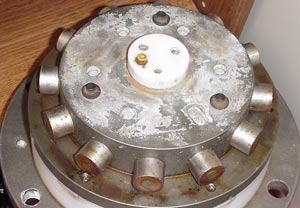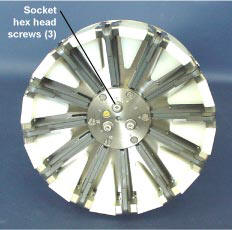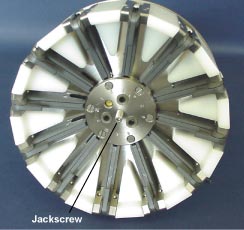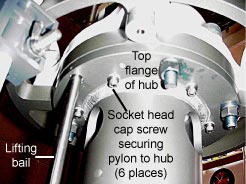APPLICATION NOTE NO. 66
Routine Maintenance for the SBE 32 Carousel Water
Sampler
Revised September 2008
![]()
This Application Note reviews corrosion precautions and routine maintenance for the SBE 32 Carousel Water Sampler. The reliability of the Carousel is sustained by establishing proper handling practices.
Note: Also see Application Note 88: Frame Coating Repair for the SBE 32 Carousel Water Sampler.
Rinsing and Cleaning
After Every Cast
If it will be More than 24 Hours Until the Next Cast
 To
prevent salt buildup on the latches (which can cause sticky latches),
Sea-Bird recommends the following:
To
prevent salt buildup on the latches (which can cause sticky latches),
Sea-Bird recommends the following:
Periodically, and if experiencing Sticky Latches
- Open (unlock) all of the latches.
- Place the latch assembly upside down on the top rack of a residential or commercial dishwasher. Run the dishwasher with regular dishwasher soap, and a no-heat dry cycle (air dry only!).
Anodes
Large zinc anodes provide corrosion protection:
Check the anodes occasionally to verify that they are securely fastened and have not eroded.
Screws
All screws exposed to seawater have been generously lubricated with Bostik's Never-Seez Blue Moly anti-seize compound (available through marine hardware stores). When disassembling/reassembling the Carousel, re-lubricate these screws with Blue Moly or equivalent. Blue Moly is electrically conductive, so be careful not to get it on circuit boards.
Note: Blue Moly is molybdenum disulfide and pure nickel flake in pressure-resistant premium grade grease, formulated without graphite, lead, or copper. See Bostik’s website (http://www.bostik-us.com/TDS/TDSFiles/NSBlueMoly.pdf) for the specifications.
If the Carousel is stored on deck, we recommend covering it to keep off salt spray and protect the plastic parts from UV rays. At a minimum, a cover for the latch assembly is a good investment.
As described above in Corrosion Precautions / Cleaning, rinse the inside and outside of each bottle with fresh water after every cast to prevent salt deposits on the tubing that closes each bottle. Periodically inspect the tubing for tears and to insure the proper amount of tension. Replace the tubing if it becomes torn or damaged from salt deposits, or is overstretched.
Removing Latch Assembly
 Photo 1 |
 Photo 2 |
- Mark the location of latch 1 (from the retainer disk) on the trigger mount disk to aid in reassembly.
- Remove the Phillips-head screws (eight for 32C and 32SC, six for full-size 32). Lift the retainer disk from the top of the latch assembly. [Photo 3]
- Pull the desired latch(es) horizontally from the trigger mount disk. Mark the latch(es) to aid in reassembly. [Photo 4]
|
|
|
Replacing Latch Assembly
|
|
 Remove the lifting bail.
Remove the lifting bail.
- Remove the hardware from underneath the lower guard ring.
- Begin to pull the lifting bail up, until it is above the lower guard ring/adapter plate/hub assembly connection.
- Remove the hardware from the legs of the lifting bail.
- Pull the lifting bail out of the upper guard ring.
NOTE:
There are plastic insulators on the underside of the following connections:
- Lower guard ring/adapter plate/hub assembly - for lifting bail
- Upper adapter plate - for pylon
Verify that the insulators have not fallen out before reinstalling the pylon and lifting bail.

![]()
Last modified: 14 Oct 2010
Sea-Bird Home Phone: (+1) 425-643-9866 Fax: (+1) 425-643-9954 E-mail: seabird@seabird.com